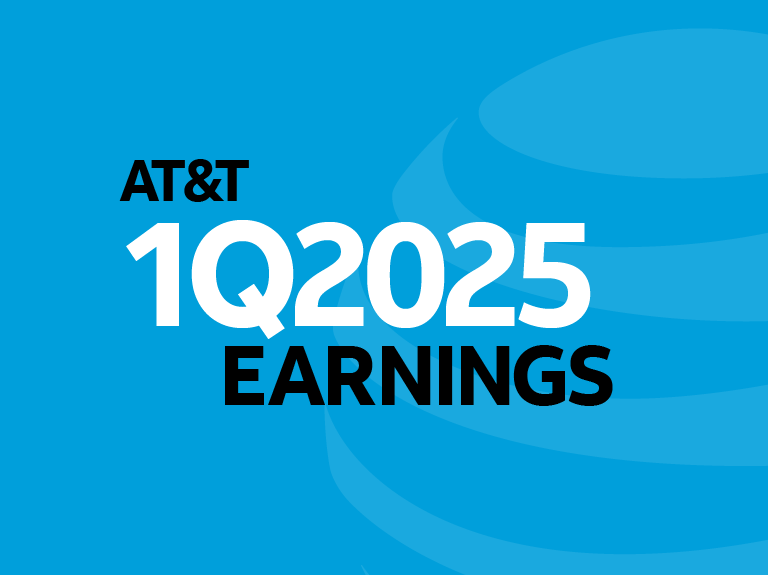AT&T Reports Second-Quarter Results
Second-Quarter Consolidated Results
- Diluted EPS of $0.51 as reported compared to $0.81 in the year-ago quarter
- Adjusted EPS of $0.89 compared to $0.91 in the year-ago quarter
- Consolidated revenues of $45.0 billion, up 15.3%
- Cash from operations of $14.3 billion, up 40%
- Capital expenditures of $5.5 billion
- Free cash flow of $8.8 billion
Company Raises Free Cash Flow Guidance to $28 Billion Range1; Reaffirms Remainder of 2019 Guidance:
- Low single-digit adjusted EPS growth2;
- Dividend payout ratio in the 50s% range1;
- End-of-year net debt to adjusted EBITDA in the 2.5x range;
- Gross capital investment in the $23 billion range3
Note: AT&T's second-quarter earnings conference call will be webcast at 8:30 a.m. ET on Wednesday, July 24, 2019. The webcast and related materials will be available on AT&T’s Investor Relations website at https://investors.att.com.
AT&T Inc. (NYSE:T) reported solid operating results in the second quarter, including consolidated revenue growth, expanding operating income margin and record operating and free cash flow.
“We’re halfway through the year and on track to deliver on all our 2019 priorities,” said Randall Stephenson, AT&T chairman and CEO. “We continue to pay down debt and are more confident than ever that we’ll meet our yearend deleveraging goal, and we’ll take a look at buying back stock. Our FirstNet build is not only running ahead of schedule – it’s become a driver of our wireless network leadership in speed, reliability and network performance. It also sets us up to have nationwide commercially available 5G coverage in the first half of 2020.
“On top of all this, our operating teams continue to deliver solid results. Our wireless business grew revenues, profitability and phone customers, both postpaid and prepaid. WarnerMedia delivered another strong quarter with both revenue and operating income growth. And our Entertainment Group profitability continued to stabilize, and even grow. Across the board, it was a solid quarter that puts us in position to have a really strong year.”
Second-Quarter Results
Communications Highlights
- Mobility:
- Recognized as the nation’s fastest4, best5 and most reliable6 network
- Service revenues up 2.4%, operating income and EBITDA growth with 355,000 phone net adds
- 144,000 postpaid smartphone net adds
- 72,000 postpaid phone net adds
- 341,000 prepaid net adds of which 283,000 were phones
- Entertainment Group:
- 2.6% operating income growth with solid video and broadband ARPU gains
- 1.1% EBITDA growth as company targets stability
- Focus on long-term value customer base
- 21.6 million premium TV subscribers – 778,000 net loss
- 1.3 million DIRECTV NOW subscribers – 168,000 net loss
- AT&T TV, company’s new thin client video service, expected to begin trials in the third quarter
- IP broadband revenue growth of 6.5%; 318,000 AT&T Fiber gains
- Nearly 14 million customer locations passed with fiber
WarnerMedia Highlights
- Solid revenue growth and strong operating income growth with gains in all business units
- Original content drives strong HBO digital subscriber growth
- HBO Max slated to launch Spring 2020
- Strong Warner Bros. operating income growth
- Continued Turner subscription revenue growth
Consolidated Financial Results
AT&T's consolidated revenues for the second quarter totaled $45.0 billion versus $39.0 billion in the year-ago quarter, up 15.3%, primarily due to the Time Warner acquisition (Deal closed on June 14, 2018). Declines in revenues from legacy wireline services, Vrio, domestic video and wireless equipment were more than offset by the addition of WarnerMedia and growth in domestic wireless services, strategic and managed business services, IP broadband and Xandr. Operating expenses were $37.5 billion versus $32.5 billion in the year-ago quarter, an increase of about $4.9 billion due in part to the Time Warner acquisition, partially offset by cost efficiencies and lower Entertainment Group and wireless equipment costs.
Operating income was $7.5 billion versus $6.5 billion in the year-ago quarter, primarily due to the Time Warner acquisition, with operating income margin of 16.7% versus 16.6%. When adjusting for amortization, merger- and integration-related expenses and other items, operating income was $9.9 billion versus $8.2 billion in the year-ago quarter, and operating income margin was 22.0% versus 21.1% in the year-ago quarter primarily due to the acquisition of Time Warner.
Second-quarter net income attributable to AT&T was $3.7 billion, or $0.51 per diluted share, versus $5.1 billion, or $0.81 per diluted share, in the year-ago quarter. Adjusting for $0.38, which includes merger-amortization costs, a non-cash actuarial loss on benefit plans, merger- and integration-related expenses and other items, earnings per diluted share was $0.89 compared to an adjusted $0.91 in the year-ago quarter.
Cash from operating activities was $14.3 billion, and capital expenditures were $5.5 billion. Capital investment – which consists of capital expenditures plus cash payments for vendor financing – totaled $6.5 billion, which includes about $1.0 billion of cash payments for vendor financing. Free cash flow — cash from operating activities minus capital expenditures — was a record $8.8 billion for the quarter.
The Company now expects:
Free cash flow guidance in the $28 billion range1
Dividend payout ratio in the 50s% range1
- 1 Free cash flow is cash from operating activities minus capital expenditures. The increase in guidance reflects higher cash from operations driven by incremental working capital efforts. Free cash flow dividend payout ratio is dividends divided by free cash flow.
Low single-digit adjusted EPS growth2
- 2 Adjustments include merger-related adjusted amortization costs in the range of $7.5 billion, a non-cash mark-to-market benefit plan gain/loss, merger integration and other adjustments. The mark-to-market adjustment is driven by interest rates and investment returns that are not reasonably estimable and can be a significant item. Accordingly, we cannot provide a reconciliation between forecasted adjusted diluted EPS and reported diluted EPS without unreasonable effort.
Gross capital investment in the $23 billion range3
- 3Excludes expected FirstNet reimbursement in the $1 billion range; includes vendor financing


